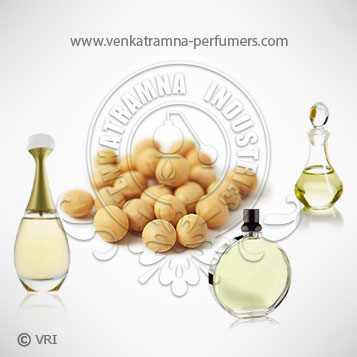
| Botanical Name | Soja Hispida |
| Common Name | Soya beans, Soybeans |
| Country of Origin | Canada |
| Solubility | Soluble in alcohol and oils. Insoluble in water |
| Specific Gravity | Not Applicable |
| Optical Rotation | Not Applicable |
| Refrective Index | Not Applicable |
| PlantPart | seed |
| Bland With | Makes a perfect blend with most of the light essential oils. |
| CAS No | 8001-22-7 |
| Flash Point | 100 °C |
| Extraction Method | Cold Pressed |
Soya bean carrier oil has extremely high content of Lecithin, Sterolins, and Vitamin E. The composition of the oil comparatively high in unsaturated fatty acids. The oil is extracted from the smooth egg shaped beans which have an oil content of about 20%. Being suitable for all types of skin, soyabean carrier oil makes a perfect base oil for various massage blends.
The first domestication of soybean has been traced to the eastern half of North China in the eleventh century B.C. or perhaps a bit earlier. Soybean has been one of the five main plant foods of China along with rice, soybeans, wheat, barley and millet. According to early authors, soybean production was localized in China until after the Chinese-Japanese war of 1894-95, when the Japanese began to import soybean oil cake for use as fertilizer. Shipments of soybeans were made to Europe about 1908, and the soybean attracted world-wide attention. Europeans had been aware of soybeans as early as 1712 through the writing of a German botanist. Some soybean seed may have been sent from China by missionaries as early as 1740 and planted in France. The first use of the word "soybean" in U.S. literature was in 1804. However, it is thought that soybean was first introduced into the American Colonies in 1765 as "Chinese vetches" . Early authors mentioned that soybeans appeared to be well adapted to Pennsylvania soil. An 1879 report from the Rutgers Agricultural College in New Jersey is the first reference that soybeans had been tested in a scientific agricultural school in the United States. For many years, most of the references to this crop were by people working in eastern and southeastern United States where it was first popular. Most of the early U.S. soybeans were used as a forage crop rather than harvested for seed. Most of the early introductions planted in these areas were obtained from China, Japan, India, Manchuria, Korea, and Taiwan. For many years, soybean acreage increased very slowly. There were only 1.8 million acres in the United States in 1924 when the first official estimate became available. At that time, most of the crop was used for hay. It was not until the 1920's that soybean acreage expanded to any great quantity in the U.S. Corn Belt. Before World War II, the U.S. imported more than 40% of its edible fats and oils. Disruption of trade routes during the war resulted in a rapid expansion of soybean acreage in the U.S. as the country looked for alternatives to these imports. Soybean was one of only two major new crops introduced into the U.S. in the twentieth century. The other major crop, Canola was initially developed in Canada and is now grown on some U.S. acres. Soybean was successful as a new crop because there was an immediate need for soybean oil and meal, its culture was similar to corn, and it benefitted other crops in a rotation. Following World War II, soybean production moved from the southern U.S. into the Corn Belt. The major soybean producing states of Iowa, Illinois, Minnesota, Indiana, Ohio, Missouri, and Nebraska produced 67 percent of the U.S. total in 2003; the southern and southeastern states of Arkansas, Mississippi, North Carolina, Kentucky, Tennessee, Louisiana, Alabama, and Georgia produced 14 percent. Other states with significant soybean acreage are South Dakota, Kansas, Michigan, Wisconsin, and North Dakota. A record 2.9 million bushel soybean crop was produced in 2001 on 74.1 million acres with an average per acre yield of 39.6 bushels. The leading soybean states are Iowa and Illinois. In 2003, Iowa had 10.6 million acres of soybeans while Illinois had 10.3 million. The highest state yield ever achieved was 50.5 bushels per acre produced by Iowa farmers in 1994. The U.S. dominated world soybean production through the 1950's, 60's, and 70's, growing more than 75 percent of the world soybean crop. The U.S. was the major supplier of animal feed protein in the world during this period. A worldwide shortage of feed protein in the early 1970's led to the initiation of large-scale soybean production in several South American countries, most notably Argentina and Brazil. By 2003, the U.S. share of the world's soybean production had shrunk to 34 percent, while Argentina's and Brazil's had increased to 18 and 28 percent, respectively. Most of the land suitable for soybean production in Argentina has been put into production. Brazil has an estimated additional 100 million acres of land that can still be put into soybean production. This land, which comprises an area larger than the U.S. Corn Belt, is remotely located in the interior of the country and faces many obstacles to further soybean prodcution.
Color : Pale yellow to yellow liquid with characteristic odor,
Aroma : Typical and Characteristic of Carrier Oils.
Oleic- 23.73% Palmitic- 9.33% Linoleic- 52.90% Linolenic- 7.30% Stearic- 3.72%
Soya bean popular with massage therapists, principally because the oil is very light, high in vitamin E etc. and a really good alternative to Sweet Almond Oil. Very easy to work with and it keeps skin supple, whilst being very light.